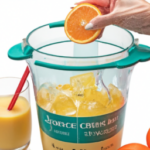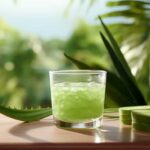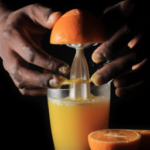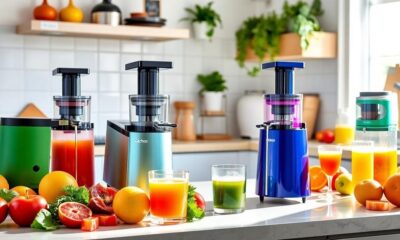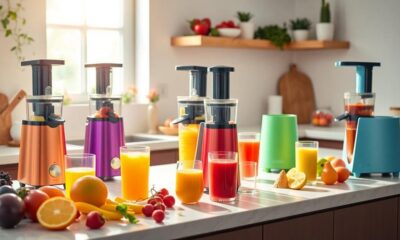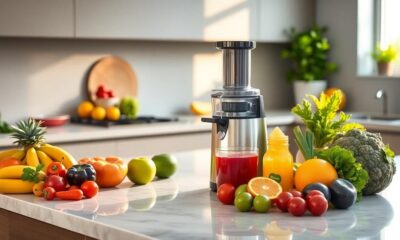Juice Tips and Tricks
How To Can Orange Juice

I absolutely love freshly squeezed orange juice, but there are occasions when I don’t have the time to make a glass every morning. This is where canning comes in handy! By canning orange juice, you can preserve the delicious taste of fresh oranges, giving you the opportunity to savor it whenever you want, any day of the year.
In this article, I’ll walk you through the step-by-step process of how to can orange juice.
First things first, it’s important to choose the right oranges for canning. You’ll want to select oranges that are juicy and sweet, such as Valencia or Navel oranges. It’s also important to ensure that the oranges are ripe, but not overripe.
Overripe oranges can lead to a sour taste and spoil quicker, while underripe oranges won’t have as much juice. With the right oranges in hand, let’s get started on the canning process!
Key Takeaways
- Choose ripe Valencia or Navel oranges for juicing and remove seeds to prevent bitterness
- Clean and sterilize equipment thoroughly to prevent contamination during canning
- Use sweeteners like honey or stevia to enhance flavor, and experiment with different orange varieties for unique flavors
- Properly process jars using a water bath canner and label them with date and preservation method for safe and organized storage.
Choose the Right Oranges
Don’t settle for just any oranges – you’ve got to pick the juiciest, sweetest ones if you want your homemade orange juice to be the real deal!
When choosing oranges for canning, it’s important to keep in mind the best orange varieties for juicing and their seasonal availability. Valencia oranges are the most common variety used for juicing because they have a high juice content and a nice balance of sweetness and acidity. They’re typically available from March to September, making them the perfect choice for summertime canning.
If Valencia oranges aren’t available, you can also use Navel oranges, which are available from November to May. They have a lower juice content, but their sweetness makes up for it. Blood oranges are another option, but they have a shorter season, from December to May.
When selecting oranges, make sure they’re ripe, firm, and heavy for their size. Avoid oranges with soft spots or blemishes, as they may not have as much juice and can affect the flavor of your orange juice.
Now that you have your oranges, it’s time to gather your equipment.
Gather Your Equipment
First things first, make sure you’ve got all the gear you need to start canning your delicious citrus beverage. You’ll need a large stockpot, a canning rack, canning jars with lids and rings, a funnel, a ladle, a timer, and a citrus juicer or press. It’s important to make sure your equipment is in good condition and properly maintained.
Check your jars for any chips or cracks, and inspect your rings and lids to ensure they’re free of rust or dents. You’ll also want to clean and sanitize your equipment before you begin.
When it comes to choosing the right oranges, there are a variety of options available. While many people opt for Valencia oranges, which are known for their juicy, sweet flesh and thin skin, there are other alternative varieties worth considering.
Blood oranges, for example, have a deep red hue and a unique, tangy flavor that can add a fun twist to your orange juice. Whichever variety you choose, make sure they’re ripe and fresh for the best flavor.
With your equipment ready and your oranges picked out, it’s time to move on to the next step: sanitizing your equipment.
Sanitize Your Equipment
Before proceeding with canning orange juice, it’s crucial to properly sanitize all equipment.
I always make sure to sterilize my jars and lids by boiling them in water for at least 10 minutes.
Additionally, I thoroughly clean my juicer or squeezer with hot soapy water to prevent any bacteria from contaminating the juice. I make sure to disassemble all the parts and scrub away any residue that might harbor germs. Proper cleaning not only ensures that the juice is safe to drink but also extends the life of the equipment. When researching how to preserve grape juice, I learned that storing it in airtight containers and refrigerating or freezing it right away helps maintain its freshness.
Safeguarding against potential contamination is key to ensuring a safe and successful canning process.
Sterilizing Jars and Lids
To sterilize your jars and lids, you’ll need to immerse them in boiling water for at least 10 minutes, ensuring they’re fully submerged. This is a critical step in the canning process, as it ensures that no harmful bacteria or microorganisms are present in the jars or lids that could spoil the juice.
It’s important to time the sterilization process carefully, as leaving the jars in boiling water for too long can cause them to crack or break. There are different sterilization methods you can use, but boiling water is the most effective and reliable.
Make sure to use a large pot or canning kettle that is deep enough to fully submerge the jars and lids. Once the sterilization process is complete, use tongs to carefully remove the jars and lids from the boiling water, and place them on a clean towel or rack to cool.
Now that your jars and lids are sterilized and ready to go, it’s time to move on to the next step: cleaning your juicer or squeezer.
Cleaning Juicer or Squeezer
Now it’s time for me to tackle cleaning my juicer or squeezer, making sure that all the pulp and residue from previous use is removed to ensure the best possible flavor and freshness for my homemade orange juice. Here are some effective cleaning methods and best cleaning products that I use to clean my juicer or squeezer:
-
Disassemble the juicer or squeezer: Remove all removable parts of the juicer or squeezer, including the blades, filters, and pulp container.
-
Soak in warm soapy water: Fill a sink or basin with warm water and add a few drops of dish soap. Submerge the removable parts in the warm soapy water and let them soak for about 10-15 minutes.
-
Scrub with a brush: Use a soft-bristled brush, such as a toothbrush, to scrub the removable parts, making sure to remove any pulp or residue that may have accumulated.
-
Rinse and dry: Rinse all the parts with clean water and dry them thoroughly with a clean towel or let them air dry.
After cleaning my juicer or squeezer, it’s time to prepare the oranges for juicing.
Prepare the Oranges
To prepare oranges for canning, I start by washing each one thoroughly with water and a bit of white vinegar to remove any dirt or residue.
Then, I use a sharp knife to carefully peel off the skin, making sure to remove as much of the white pith as possible.
Next, I cut the oranges into smaller pieces and remove any seeds before juicing them. This ensures that the juice is smooth and free of any unwanted bits.
Washing and Peeling
After scrubbin’ those oranges clean and givin’ ’em a good peel, you’ll be ready to start juicin’. But before we get to that, let’s talk about washing and peeling.
It’s important to wash the oranges thoroughly to remove any dirt or residue. Once you’ve done that, you can start peeling the oranges. Don’t throw away the peels just yet! Did you know that orange peels are packed with nutrients and can provide several health benefits? Eating orange peels can help lower cholesterol levels, boost digestion, and even aid in weight loss.
When it comes to juicing, different orange varieties can produce different flavors and levels of sweetness. Some of the most popular orange varieties for juicing include Valencia, Navel, and Blood oranges.
Once you’ve chosen your oranges and washed them, it’s time to start peeling. Use a sharp knife to remove the outer layer of skin, being careful not to remove too much of the white pith underneath. After you’ve peeled the oranges, cut them into smaller pieces and remove any seeds.
Now that we’ve covered washing, peeling, and choosing the right oranges, it’s time to move on to the next step of removing the seeds.
Removing Seeds
You can’t miss the step of ridding those pesky seeds from your precious fruit. Seedless oranges aren’t always readily available, but there are alternative methods for removing seeds.
One method is to cut the oranges in half and use a spoon or knife to scoop out the seeds. Another method is to use a citrus juicer that has a built-in strainer to catch the seeds as the juice is extracted.
It’s important to remove the seeds because they can add a bitter taste to the juice and also make it difficult to drink. Plus, no one wants to be constantly spitting out seeds while enjoying a refreshing glass of orange juice.
Once the seeds are removed, the oranges are ready to be juiced and turned into a delicious and nutritious drink.
Juicing the Oranges
Now it’s time to get that sweet, tangy nectar flowing – simply slice those babies in half, pop them in your juicer, and watch as the machine expertly extracts every last bit of liquid gold.
Juicing oranges is a simple process, but there are a few techniques that can help you get the most out of your fruit. Here are three tips to make your juicing experience even better:
-
Choose the right oranges: Not all oranges are created equal. Some varieties, like Valencia oranges, are sweeter and juicier than others. Look for oranges that are heavy for their size, as this indicates they are full of juice. If possible, use freshly picked oranges for the best flavor.
-
Roll the oranges first: Before juicing, roll the oranges on the counter with your hand. This helps to break down the fibers and release more juice. You can also microwave the oranges for a few seconds to warm them up, which also helps to extract more juice.
-
Use a slow juicer: If you have a slow juicer, use it for juicing oranges. Slow juicers are more efficient at extracting juice and produce less heat, which helps to preserve the nutrients in the juice.
Now that you’ve juiced your oranges, it’s time to add sweetener (optional).
Add Sweetener (Optional)
If you want your orange juice to be sweeter, feel free to add sweetener to taste. Alternative sweeteners like honey, agave, or stevia are great options if you’re looking to reduce sugar.
Keep in mind that adding sweetener will affect the overall taste and nutritional value of your juice, so use it sparingly and adjust to your preferences. When adding sweetener, it’s important to mix it well with the juice to ensure an even flavor.
Be sure to taste the juice as you go and add more sweetener if needed. Once you’re satisfied with the taste, it’s time to move on to filling the jars.
Fill the Jars
Next, grab your jars and carefully pour the freshly made mixture into them, making sure to leave a bit of space at the top for expansion during freezing. The jar size you choose will depend on how much orange juice you want to store.
I recommend using quart-sized jars for larger batches and pint-sized jars for smaller ones. It’s also important to choose jars that are safe for freezing, such as canning jars, to avoid cracking or breaking during the freezing process.
Once you have filled the jars, it’s time to decide on your storage options. You can store the jars in the refrigerator for up to a week, or you can freeze them for longer term storage. If you choose to freeze the jars, make sure to label them with the date and contents for easy identification.
In the next section, we’ll discuss how to process the jars to ensure they’re safe for consumption.
Process the Jars
To ensure the safety of your homemade orange juice, it’s crucial to properly process the jars before consumption. There are different ways to do this, but the most common method is by using a water bath canner.
Simply place the filled jars in the canner, add water until they are fully submerged, and boil for a specified amount of time. This process kills any bacteria that may be present in the juice and creates a vacuum seal for jar storage.
It’s important to note that different recipes may require different processing times, so be sure to follow the instructions carefully. Properly processed jars can last up to a year on the shelf, but it’s still important to label and date each jar for future reference.
This way, you can ensure that you are consuming fresh, safe juice every time. With the jars processed and labeled, the next step is to enjoy your delicious homemade orange juice!
Label and Date
After properly processing the jars, it’s essential to label and date them for future reference, just like planting a seed and watching it grow into a beautiful flower. Proper labeling ensures that you can easily identify your jars of orange juice and keep track of their shelf life extension. Here’s an example of a simple yet informative label that you can use:
| Label | Date | Processing Method |
|---|---|---|
| OJ | 10/1 | Boiling Water |
The label includes the abbreviation for orange juice, the date of processing, and the method used to preserve it. This way, you can easily identify which jar to use first based on its processing date and method. Additionally, you can also keep track of how long the orange juice will last in your pantry or fridge.
Labeling and dating your jars properly can also help you avoid any potential food safety issues. Knowing the processing date and method can help you determine if the orange juice is still safe to consume. With proper labeling, you can confidently enjoy your homemade orange juice knowing that it’s fresh and safe to drink.
Enjoy Your Homemade Orange Juice
Now that you’ve gone through the process of labeling and dating your jars, it’s time to sit back, relax, and savor the delicious taste of your homemade creation. You may have noticed that the flavor of your orange juice varies slightly from batch to batch. This is completely normal and is a result of the natural variations in the oranges you use. Don’t be afraid to experiment with different varieties of oranges to find the flavor that suits you best.
When it comes to serving your homemade orange juice, there are many options to choose from. Some people prefer to drink it straight from the jar, while others like to mix it with other juices or use it as a base for cocktails. You can also add a dash of honey or cinnamon for a unique twist on the classic flavor. Whatever your preference, make sure to serve your orange juice chilled for the best taste.
As you enjoy your homemade orange juice, keep in mind that sometimes issues may arise during the canning process. Don’t worry, we’ve got you covered with some troubleshooting tips to help you overcome any obstacles that may come your way.
Troubleshooting Tips
Sometimes, even the most experienced canners encounter common problems during the process of canning orange juice. The good news is that most of these issues can be solved with simple troubleshooting techniques.
Here are some common problems you may encounter and how to fix them:
-
The jars didn’t seal properly. This can happen if the jars weren’t filled to the correct level, the rims weren’t clean, or the lids weren’t tightened enough. To fix this, reprocess the jars using new lids and make sure to fill them to the correct level, wipe the rims clean, and tighten the lids securely.
-
The juice turned brown or discolored. This can happen if the oranges were too ripe or if the juice was exposed to sunlight or air. To prevent this, use fresh, ripe oranges and work quickly to minimize exposure to air and sunlight. If the juice does turn brown, it’s still safe to drink, but it may not taste as good.
By following these troubleshooting tips, you can ensure that your homemade orange juice is safe, delicious, and free from common canning problems. Don’t be discouraged if you encounter an issue – just take a deep breath, follow these steps, and continue enjoying your homemade creation!
Frequently Asked Questions
How long does canned orange juice last?
I’ve found that canned orange juice can last up to 2 years if stored in a cool, dark place. However, it’s important to always check for signs of spoilage before consuming. Following proper storage recommendations can help extend its shelf life.
Can I use other types of citrus fruit to make canned juice?
Yes, I’ve experimented with Alternative Citrus fruits like lemons and grapefruits and found that they work well with Canning Techniques. However, the acidity levels and sugar content need to be adjusted for optimal preservation and taste.
Can I add other ingredients, such as spices, to the juice before canning?
Spice up your canned juice game by adding spices to your citrus juice before canning. Experiment with flavor variations by using cinnamon, ginger, or even chili powder. Be precise with measurements to ensure safety and enjoy the delicious results.
How do I know if my canned orange juice has gone bad?
To check freshness and spoilage signs in canned orange juice, look for bulging lids, off-color liquid, or a foul odor. Shelf life varies but can be extended with proper pressure canning safety and juicing techniques. Flavor variations may also occur over time.
Is it safe to can orange juice using a pressure canner instead of a water bath canner?
Pressure canning orange juice is safe but requires special equipment and careful attention to best practices. Unlike water bath canning, using a pressure canner allows for alternatives like canned juice with pulp. Pros include longer shelf life, but cons include higher risk of error and potential for spoilage.
Conclusion
In conclusion, canning orange juice is a rewarding process that can provide you with fresh and delicious juice throughout the year. As I’m enjoying my homemade orange juice, I can’t help but think of the symbolism behind it.
Just as oranges are a symbol of warmth, happiness, and good health, the act of canning represents preservation, patience, and self-sufficiency. By taking the time to carefully select, prepare, and can your own orange juice, you’re not only preserving its natural goodness, but also taking control of what you consume.
It’s a small act of self-sufficiency that can bring a sense of satisfaction and pride. So, whether you’re canning for fun or necessity, embrace the symbolism behind it and enjoy the fruits of your labor.
Cindy thoroughly researches juicing trends, techniques, and recipes to provide readers with practical advice and inspiration. Her writing style is accessible, engaging, and designed to make complex concepts easy to understand. Cindy’s dedication to promoting the advantages of juicing shines through her work, empowering readers to make positive changes in their lives through the simple act of juicing.
Juice Tips and Tricks
How to Make Aloe Vera Juice Taste Better

Tired of the strong flavor of aloe vera juice? No problem, we’ve got the answer for you.
In this article, we’ll share some tips and tricks to make your aloe vera juice taste better. We have tried and tested various methods to enhance the flavor without compromising the health benefits.
From choosing the right juice to adding natural sweeteners and infusing with fruits and herbs, we’ve got all the information you need to transform your aloe vera juice into a delightful and refreshing beverage.
Let’s dive in!
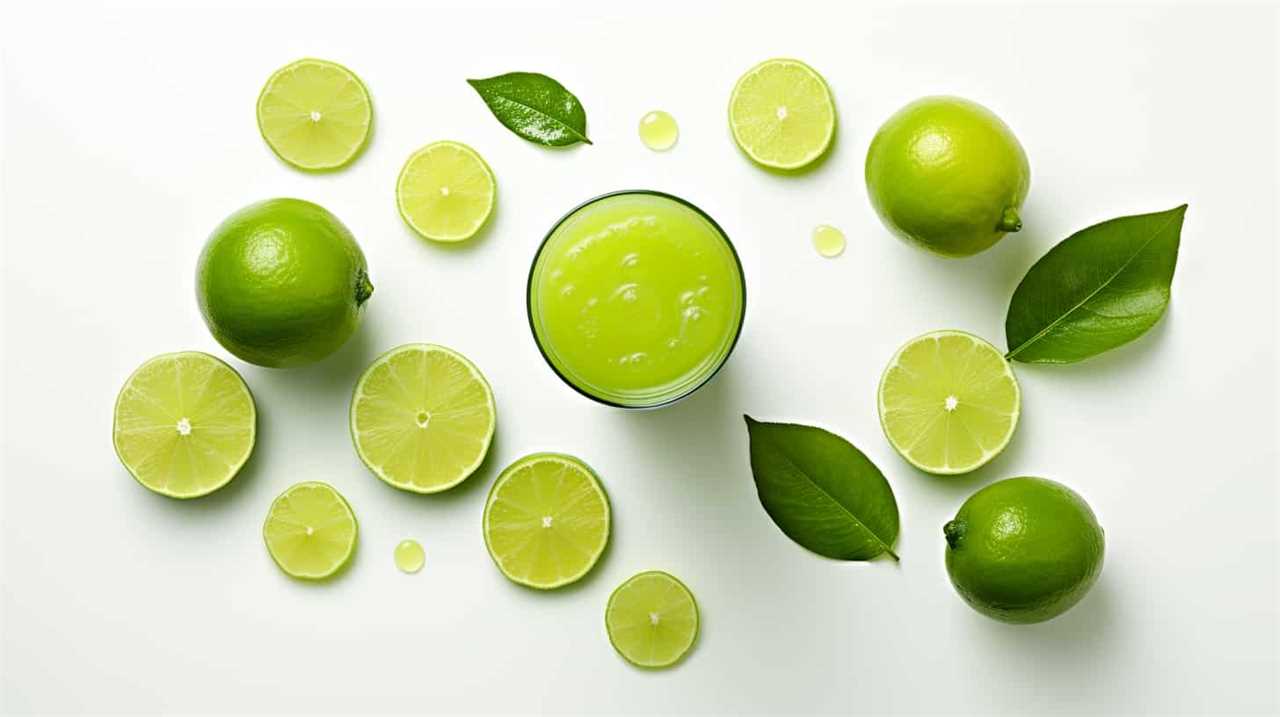
Key Takeaways
- Choose a reputable brand of aloe vera juice that prioritizes quality and uses organic, pure aloe vera.
- Avoid brands that contain added sugars or artificial ingredients.
- Use natural sweeteners like honey, agave syrup, or stevia to enhance the taste of aloe vera juice.
- Experiment with adding fruits, herbs, and other juices to create unique flavor combinations and enhance the health benefits of aloe vera juice.
Choosing the Right Aloe Vera Juice
We can enhance our experience with aloe vera juice by selecting the right brand and type for our preferences. When it comes to finding a reputable brand, it’s important to do some research and read reviews from other consumers. Look for brands that prioritize quality and use organic, pure aloe vera without any added sugars or artificial ingredients. Understanding the health benefits of aloe vera juice is also crucial in making the right choice. Aloe vera is known for its soothing properties, aiding digestion, promoting skin health, and boosting the immune system. By choosing a high-quality brand, we can ensure that we’re getting the maximum benefits from our aloe vera juice.
Now that we know how to choose the right brand, let’s move on to the next step of adding natural sweeteners.
Adding Natural Sweeteners
To enhance the flavor of our aloe vera juice, we can add natural sweeteners such as honey or agave syrup. Using alternative sweeteners not only adds sweetness but also brings unique flavors to the juice. Here are some options to consider:
- Stevia: A natural sweetener derived from the Stevia plant, it’s a zero-calorie alternative to sugar.
- Maple Syrup: This natural sweetener adds a rich and earthy flavor to the aloe vera juice.
- Dates: Pureed dates can be used to sweeten the juice while also providing essential nutrients like fiber.
In addition to using alternative sweeteners, we can enhance the flavor of aloe vera juice by adding spices and extracts. Cinnamon, ginger, or vanilla extract can add warmth and depth to the taste. By experimenting with different combinations of these natural sweeteners, spices, and extracts, we can create a flavor profile that suits our preferences.
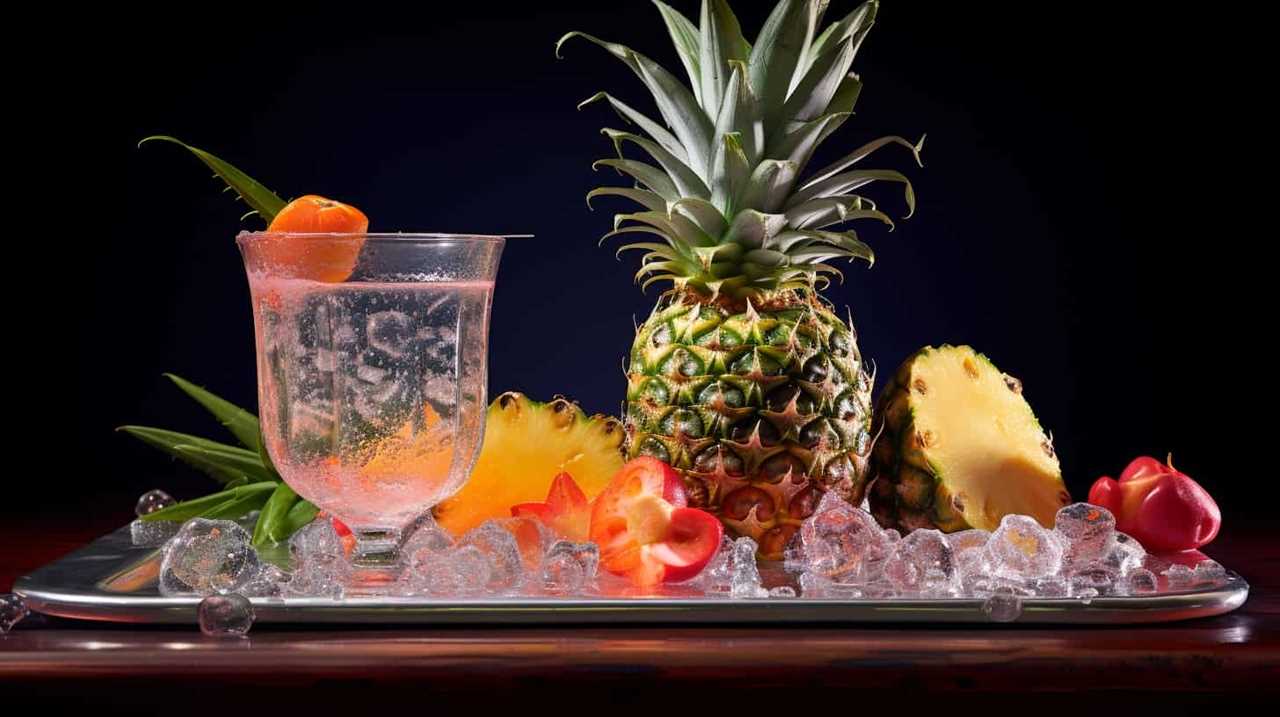
Now, let’s move on to the next section and learn how to infuse aloe vera juice with fruits and herbs to further enhance its taste.
Infusing With Fruits and Herbs
As we explore ways to make our aloe vera juice taste better, one option to consider is infusing it with fruits and herbs. Creating unique aloe vera blends by adding fruits and herbs not only enhances the flavor but also adds a touch of freshness and complexity to the juice. For example, combining aloe vera juice with lemon, mint, or berries can create a refreshing drink that’s both delicious and packed with additional nutrients. It’s similar to the ease of making lemonade with bottled juice—quick, convenient, and customizable to suit your preferences. By experimenting with different fruit and herb combinations, you can elevate your aloe vera juice experience while still reaping its health benefits.
Fruits like strawberries, pineapple, or citrus can add a burst of sweetness, while herbs like mint, basil, or ginger can provide a subtle yet refreshing twist. Exploring the benefits of herbal infusions can also be beneficial for our health. For example, adding a few sprigs of lavender can promote relaxation and reduce stress. Additionally, infusing aloe vera juice with rosemary can aid digestion and boost the immune system.
Blending With Other Juices
Let’s try mixing aloe vera juice with different fruit juices to create delicious and refreshing blends. Blending aloe vera juice with other fruits not only enhances its taste but also adds nutritional benefits to your drink. Here are three fruit juices that you can mix with aloe vera juice:

- Orange juice: Combining aloe vera juice with orange juice not only adds a tangy flavor but also boosts your intake of vitamin C, which is essential for a strong immune system.
- Pineapple juice: Mixing aloe vera juice with pineapple juice creates a tropical blend that isn’t only refreshing but also helps in digestion. Pineapple contains bromelain, an enzyme that aids in breaking down proteins and promoting better digestion.
- Watermelon juice: Blending aloe vera juice with watermelon juice creates a hydrating and refreshing combination. Watermelon is rich in water content and contains electrolytes that can help replenish your body’s fluids.
Experimenting With Flavor Combinations
While we can try various flavor combinations with aloe vera juice, it’s important to find the right balance to enhance its taste. Experimenting with different flavors can’t only make the juice more enjoyable but also enhance its health benefits.
Aloe vera juice is known for its numerous health benefits, such as boosting digestion, promoting hydration, and supporting the immune system. By adding complementary flavors, we can create a refreshing summer drink that not only tastes great but also provides a nutritional boost.
Some popular flavor combinations include mixing aloe vera juice with citrus fruits like lemon or orange, adding a splash of coconut water for a tropical twist, or combining it with cucumber and mint for a refreshing and cooling effect.
Don’t be afraid to get creative and find the flavor combination that suits your taste buds best!
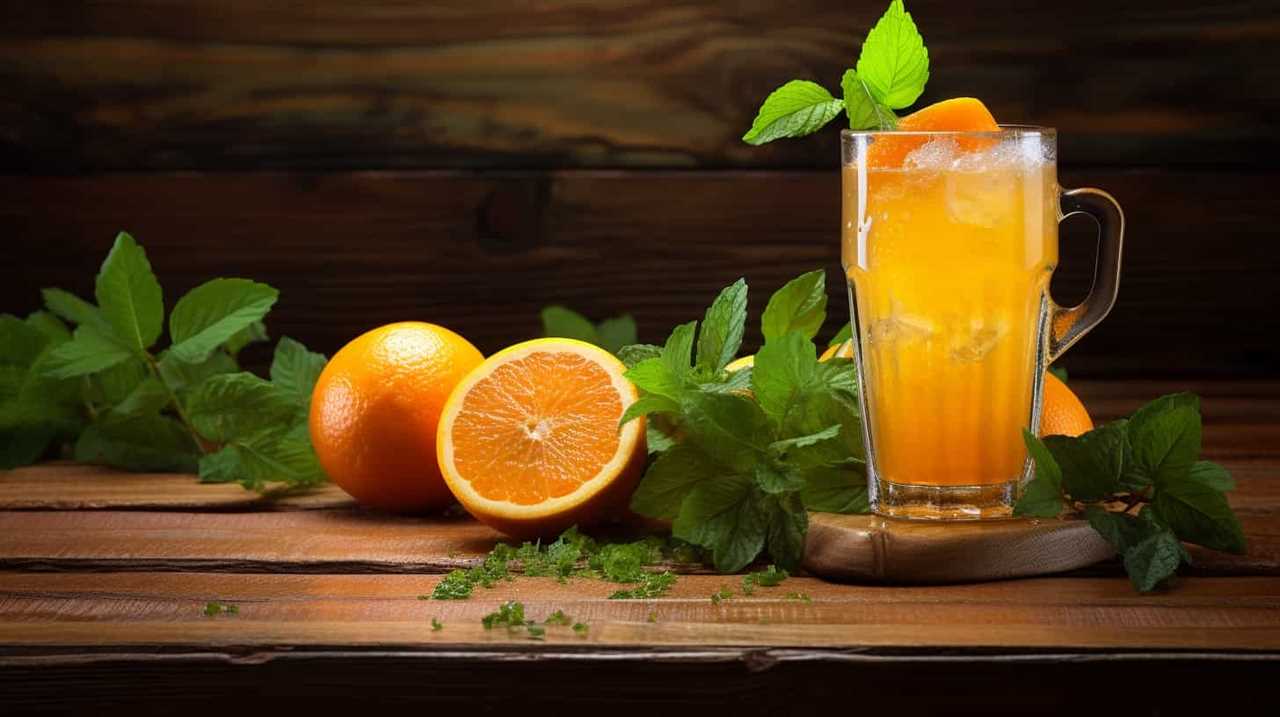
Frequently Asked Questions
Can I Use Store-Bought Aloe Vera Gel Instead of Fresh Aloe Vera for Making Juice?
Yes, you can use store-bought aloe vera gel instead of fresh aloe vera for making juice. However, it’s important to note that fresh aloe vera juice may have more health benefits due to its higher nutrient content.
How Long Can I Store Aloe Vera Juice in the Refrigerator?
Aloe vera juice can be stored in the refrigerator for up to a week. Refrigeration helps maintain the longevity and freshness of the juice, preserving its beneficial properties. It’s important to store the juice in an airtight container to prevent contamination and maintain its quality. Similarly, you might wonder *how long ginger juice lasts*; typically, fresh ginger juice can be refrigerated for about 1–2 weeks as well. Both aloe vera and ginger juices are best consumed within their shelf life to ensure maximum potency and health benefits. Additionally, freezing either juice can extend their shelf life, though some loss of nutrients and potency may occur during the process. When thinking about *how long fresh juice lasts*, it’s crucial to check for signs of spoilage, such as changes in smell, taste, or color, before consuming. To enjoy the best results, it’s always recommended to use fresh ingredients and properly store the juice to ensure you’re getting the most out of its health benefits.
Can Aloe Vera Juice Help With Digestive Issues?
Aloe vera juice can potentially help with digestive issues when taken in appropriate dosages. However, it is important to note that there may be potential side effects. It is always best to consult with a healthcare professional before starting any new supplement regimen.
Can I Use Artificial Sweeteners Instead of Natural Sweeteners in My Aloe Vera Juice?
Using artificial sweeteners in aloe vera juice may affect its taste and potential health benefits. However, natural sweeteners like honey or stevia can enhance the flavor without compromising its nutritional value.

Is It Safe to Drink Aloe Vera Juice Every Day?
Drinking aloe vera juice daily can have numerous benefits, such as improving digestion and boosting the immune system. However, consuming it regularly may also lead to potential side effects like diarrhea or stomach cramps.
Conclusion
In conclusion, making aloe vera juice taste better is easy and enjoyable.
By choosing the right aloe vera juice and adding natural sweeteners, infusing with fruits and herbs, blending with other juices, and experimenting with flavor combinations, you can create a delightful and refreshing drink.
So go ahead and unleash your creativity in the kitchen, and transform your aloe vera juice into a sensational elixir that will transport your taste buds to paradise.
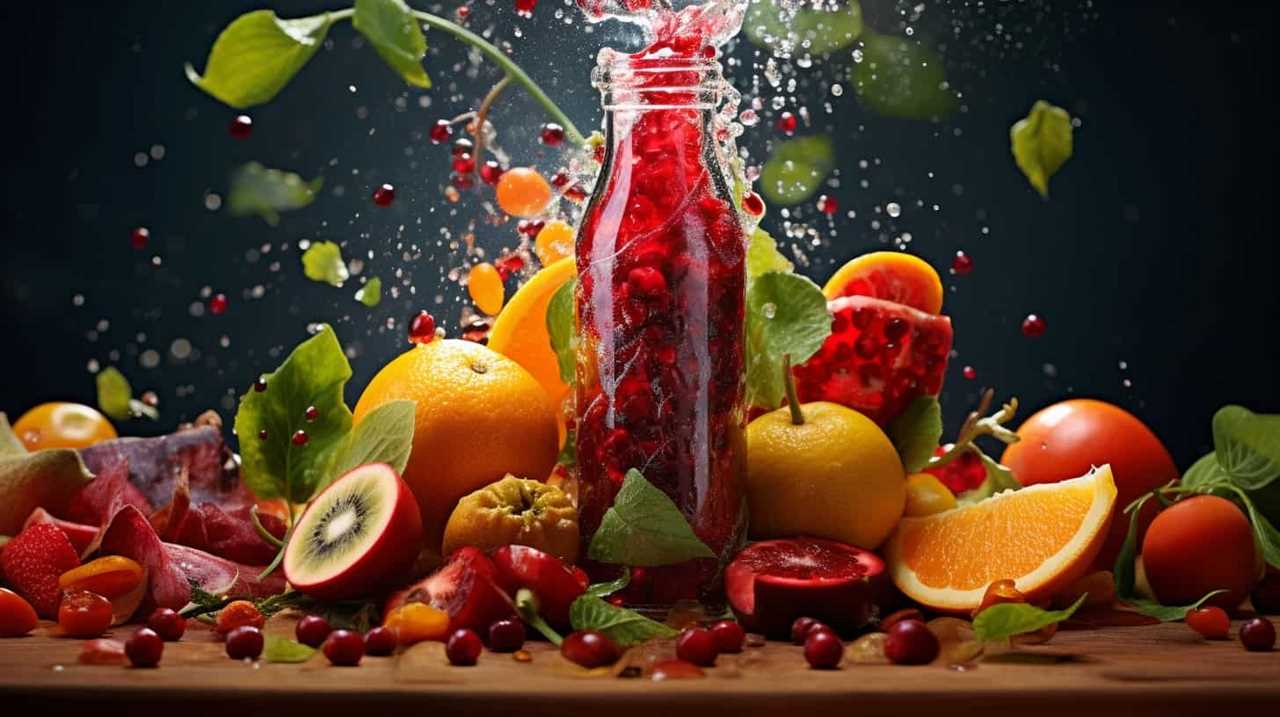
Susannah expertise lies in researching and compiling evidence-based content on juicing, nutrition, and overall health. She is committed to ensuring that The Juicery World offers accurate, up-to-date, and trustworthy information to empower readers to take control of their health. Susannah’s goal is to inspire individuals to embrace juicing as a way to nourish their bodies and live their best lives.
Juice Tips and Tricks
How to Make a Glass of Lemonade With Bottled Lemon Juice

Are you craving a cool glass of lemonade to quench your thirst? Look no further! Try out our perfect recipe using bottled lemon juice that will surely please your taste buds.
In this article, we’ll guide you through the process of creating a tangy and sweet concoction that will leave you feeling refreshed and satisfied.
So grab your ingredients and let’s get started on this delightful journey of serving ourselves and others a glass of pure lemony goodness.
Key Takeaways
- Consider the storage of the bottled lemon juice (dark glass or plastic bottles, protect from light exposure, check expiration date)
- Choose a suitable pitcher and fresh lemons for enhanced flavor
- Store the lemonade concentrate in the refrigerator to maintain freshness
- Adjust the sweetness and tartness to taste with sugar or more lemon juice, and experiment with different sweeteners or additional flavors.
Choosing the Right Bottled Lemon Juice
What are the key factors we should consider when selecting the right bottled lemon juice for our lemonade?

One important factor is how the lemon juice is stored. Look for bottles that are made of dark glass or plastic, as they help protect the juice from light exposure, which can degrade its quality. It’s also important to check the expiration date to ensure freshness.
Another benefit of using bottled lemon juice is convenience. It saves time and effort compared to squeezing fresh lemons. Additionally, bottled lemon juice provides consistent flavor, as the acidity levels are standardized.
When selecting a brand, consider reading reviews and checking for certifications, such as organic or non-GMO.
Gathering the Necessary Ingredients and Tools
How can we gather all the necessary ingredients and tools to make a glass of lemonade with bottled lemon juice? First, we’ll need to collect bottled lemon juice, sugar, and cold water, as well as a pitcher and a spoon for mixing. If you prefer extra flavor, you can also gather ice and optional add-ins like mint or soda water. While preparing the lemonade, it’s easy to understand why some people wonder about other citrus drinks and may ask, “how many oranges per gallon” are needed when making orange juice instead. Once everything is assembled, combine the lemon juice, sugar, and water in the pitcher, stirring until the sugar dissolves. Feel free to adjust the sweetness or tartness to your liking, and don’t forget to add ice or any optional add-ins for an extra refreshing touch. This process might even make you curious about how much juice from oranges is needed when making fresh orange juice compared to using bottled citrus products. Once your lemonade is ready, pour it into a glass and enjoy the refreshing taste. This simple recipe can inspire you to try other homemade juices, such as learning **how to make pear juice** or experimenting with other fruit combinations. Whether you’re using fresh fruits or bottled options, creating your own beverages is a fun and rewarding way to personalize your drinks.
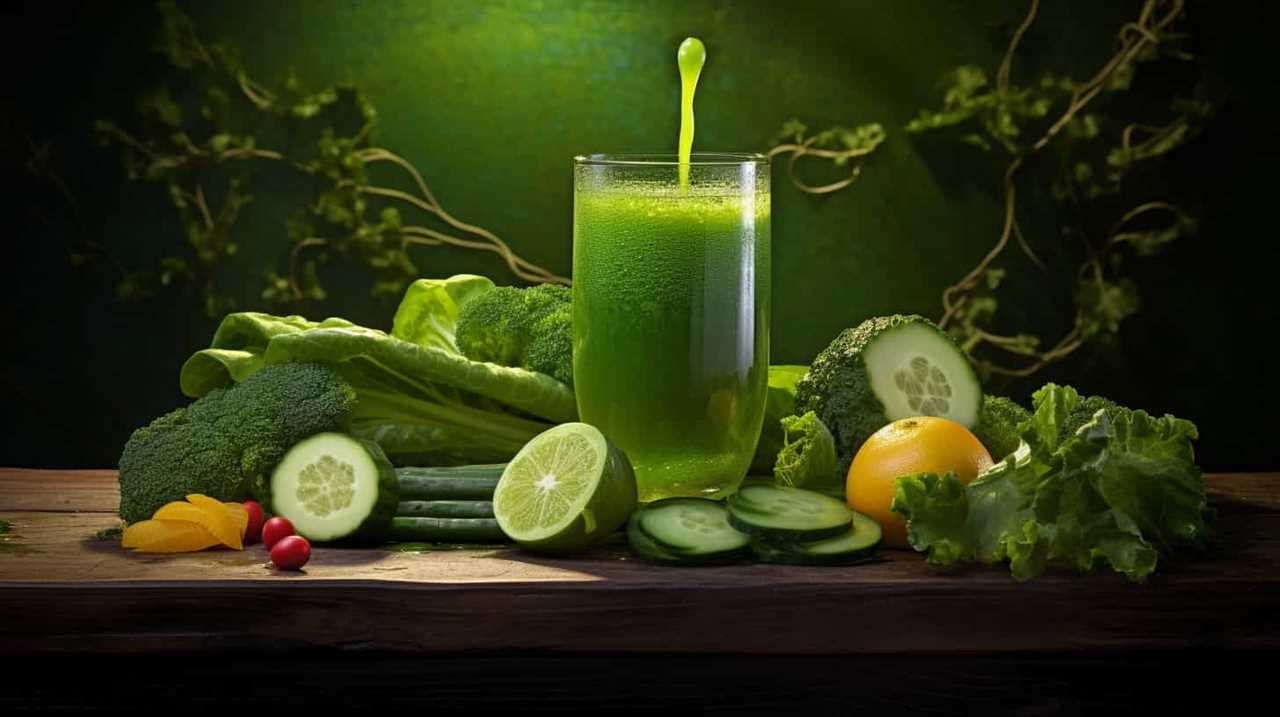
It’s important to start with the right pitcher. Look for a pitcher that’s made of glass or BPA-free plastic, as these materials won’t affect the taste of the lemonade. The pitcher should also have a lid or cover to keep the lemonade fresh and prevent spills.
Now, let’s talk about the lemons. While bottled lemon juice is convenient, using fresh lemons instead can elevate the flavor of your lemonade. Choose lemons that are firm and have a bright yellow color. Give them a gentle squeeze to ensure they’re juicy. To extract the juice, you’ll need a citrus juicer or a reamer. These tools make it easy to get every last drop of juice from the lemons.
Mixing the Lemonade Concentrate
To start mixing the lemonade concentrate, we’ll slowly pour the bottled lemon juice into the pitcher. It’s important to choose the right container for the lemonade concentrate. A pitcher with a lid or a tightly sealed container will help maintain the freshness and prevent any spills or leaks. Once the lemon juice is in the pitcher, we can move on to the next step of adding water and sweetener.
To ensure the lemonade concentrate stays fresh, it’s essential to store it properly. Keep the pitcher in the refrigerator to maintain its cool temperature and prevent any bacteria growth. If you have any leftover concentrate, transfer it to a smaller container with an airtight lid before refrigerating. This will help retain its flavor and prevent any contamination.
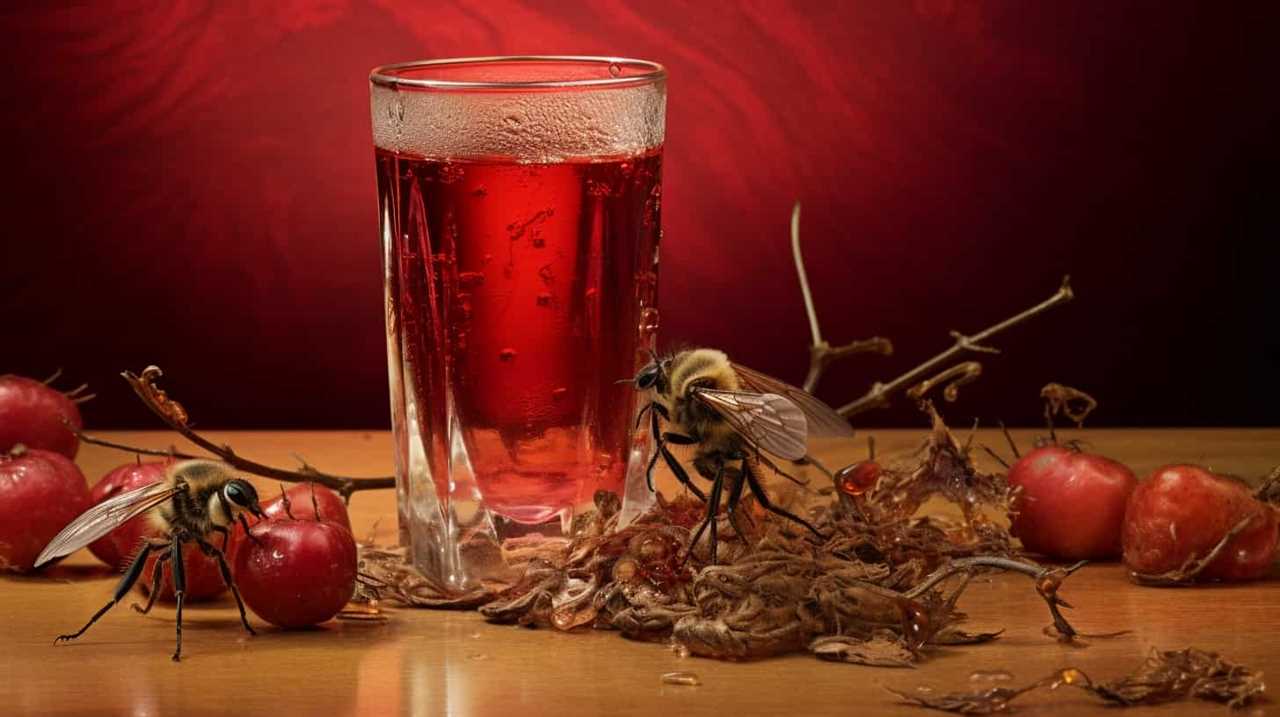
Now that we’ve mixed the lemonade concentrate, it’s time to adjust the sweetness and tartness to taste.
Adjusting the Sweetness and Tartness to Taste
We can adjust the sweetness and tartness of the lemonade to taste by adding more sugar or lemon juice, respectively. If you prefer a sweeter lemonade, simply add more sugar and stir until it dissolves completely. You can experiment with different sweeteners such as honey or agave syrup to find the perfect balance of sweetness.
On the other hand, if you want a tangier lemonade, add more lemon juice gradually, tasting as you go until it reaches your desired level of tartness.
Additionally, you can get creative with your lemonade by adding flavors like fresh mint leaves or a hint of lavender. These additions can elevate the flavor profile and create a more refreshing and unique experience.
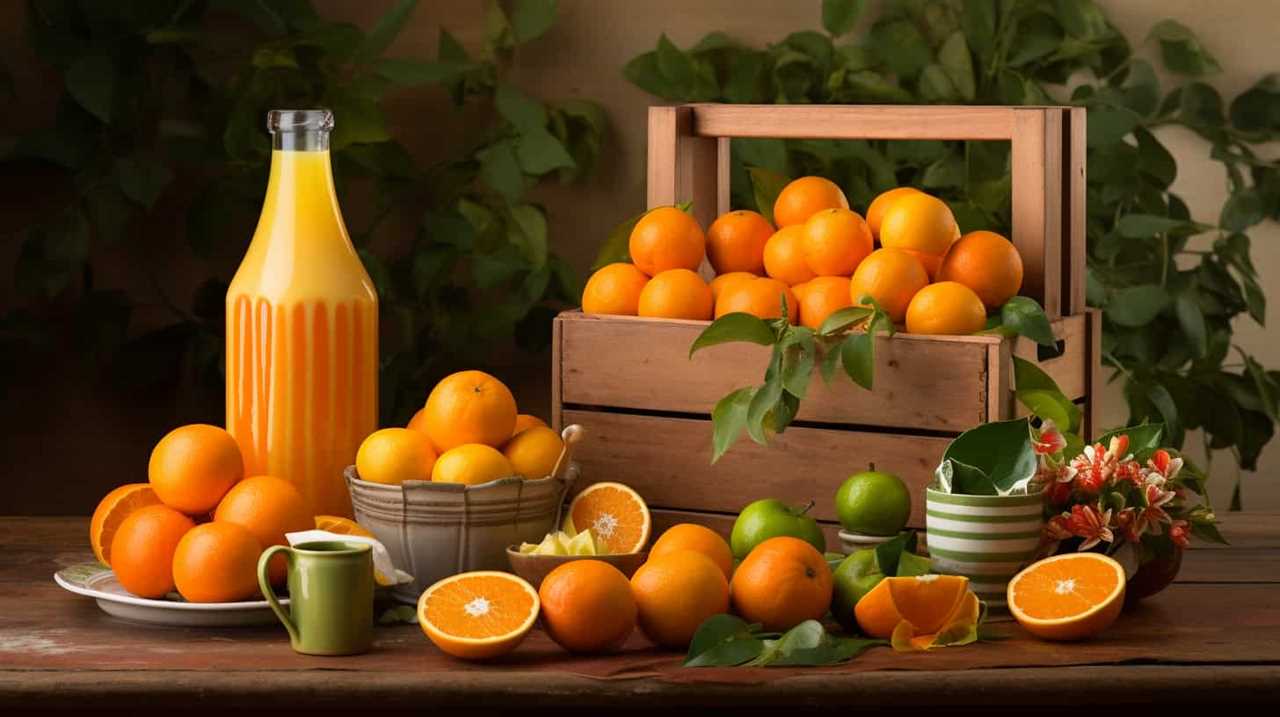
Now that we’ve adjusted the sweetness and tartness of our lemonade, let’s move on to serving and enjoying your refreshing glass of lemonade.
Serving and Enjoying Your Refreshing Glass of Lemonade
Now let’s sit back, relax, and savor our refreshing glass of lemonade.
When it comes to serving and enjoying this delightful drink, there are a few techniques and garnishing options to consider.
Firstly, serving your lemonade chilled is essential for maximum enjoyment. Ensure that you have chilled glasses or add ice cubes to the glasses before pouring the lemonade.

To add a touch of elegance, you can garnish your lemonade with a slice of lemon on the rim of the glass. For an extra burst of flavor, you could also add a sprig of fresh mint or a few berries.
Remember to gently stir the lemonade before serving to evenly distribute the flavors.
Now, take a sip, feel the refreshing tang of lemon, and let the sweet and tart flavors dance on your taste buds.
Cheers!

Frequently Asked Questions
Can I Use Fresh Lemons Instead of Bottled Lemon Juice?
Fresh lemons offer numerous benefits over bottled lemon juice. The taste of fresh lemons is unparalleled, providing a vibrant and tangy flavor. Incorporating fresh lemons into your lemonade will elevate its taste and give it a refreshing and authentic twist.
Can I Substitute Sugar With a Different Sweetener?
Substituting sweeteners in lemonade can enhance the flavor and offer health benefits. We’re knowledgeable about alternative sweeteners and can provide precise, detailed instructions on using them in place of sugar.
How Long Does the Lemonade Concentrate Need to Chill in the Refrigerator?
The chilling time for the lemonade concentrate in the refrigerator is typically around 1-2 hours. Using bottled lemon juice offers the benefit of convenience and consistent flavor for a refreshing glass of lemonade.
Can I Add Other Fruits or Flavors to the Lemonade?
Sure, we can definitely add different fruits or flavors to our lemonade. It’s a great way to experiment with unique flavors and create refreshing, personalized drinks. The possibilities are endless!

How Long Does the Lemonade Stay Fresh in the Refrigerator?
Lemonade made with bottled lemon juice can stay fresh in the refrigerator for about 5-7 days. To maximize shelf life, store it in an airtight container and keep it chilled.
Conclusion
And so, with a few simple steps and the right ingredients, a glass of refreshing lemonade is born.
Like a symphony of flavors dancing on your taste buds, this tangy elixir quenches thirst and brings joy on a hot summer day.
Just a sip transports you to a world of citrusy delight, where the sweetness and tartness blend harmoniously.

So go ahead, indulge in the art of lemonade-making and savor every drop of this sun-kissed nectar.
Cheers to the perfect glass of lemonade!
Susannah expertise lies in researching and compiling evidence-based content on juicing, nutrition, and overall health. She is committed to ensuring that The Juicery World offers accurate, up-to-date, and trustworthy information to empower readers to take control of their health. Susannah’s goal is to inspire individuals to embrace juicing as a way to nourish their bodies and live their best lives.
Juice Tips and Tricks
How to Know if Orange Juice Is Bad

We’ve all been in that situation before – reaching for a glass of orange juice and hesitating, unsure if it’s still okay to drink. Fear not! This article will give you the knowledge you need to determine for sure if your orange juice is still fresh or if it’s gone bad.
With a blend of scientific precision and practical tips, we’ll explore color changes, strange smells, off taste, texture changes, and mold or growth that may indicate spoilage.
Let’s dive in and serve ourselves a refreshing glass of certainty!
Key Takeaways
- Color changes in orange juice can indicate a loss of freshness and shelf life extension, but it doesn’t necessarily mean the juice is bad.
- Unusual or off-putting odors in orange juice, such as sour or fermented scents, can be a sign of poor quality.
- An off taste in orange juice, such as sour, bitter, or fermented flavors, suggests that the juice is spoiled.
- Texture changes in orange juice, such as pulp separation or a thicker consistency, can occur as the juice ages, so it’s important to consume it before the expiration date.
Color Changes in Orange Juice
We should be aware that color changes can indicate whether orange juice is bad.

When it comes to orange juice, color is a crucial factor to consider. As oranges are exposed to air, an oxidation process occurs, which leads to changes in color. Fresh orange juice has a vibrant orange hue, indicating its freshness and high nutritional value.
However, as time passes, the juice may undergo a color change, turning dull or brownish. This change in color is a result of the oxidation process, which affects the flavor and quality of the juice. It’s important to note that while a change in color doesn’t necessarily mean the juice is bad, it does indicate that the juice is losing its freshness and shelf life extension.
Therefore, it’s advisable to consume orange juice when it’s at its freshest, as indicated by its vibrant orange color.
Strange Smells in Orange Juice
When it comes to evaluating orange juice, we should be cautious of any strange smells or odors. A fresh, pleasant smell is indicative of good quality orange juice. However, if you notice any unusual or off-putting odors, it may be a sign that the juice has gone bad. These smells can range from a sour or fermented scent to a rancid or moldy aroma.
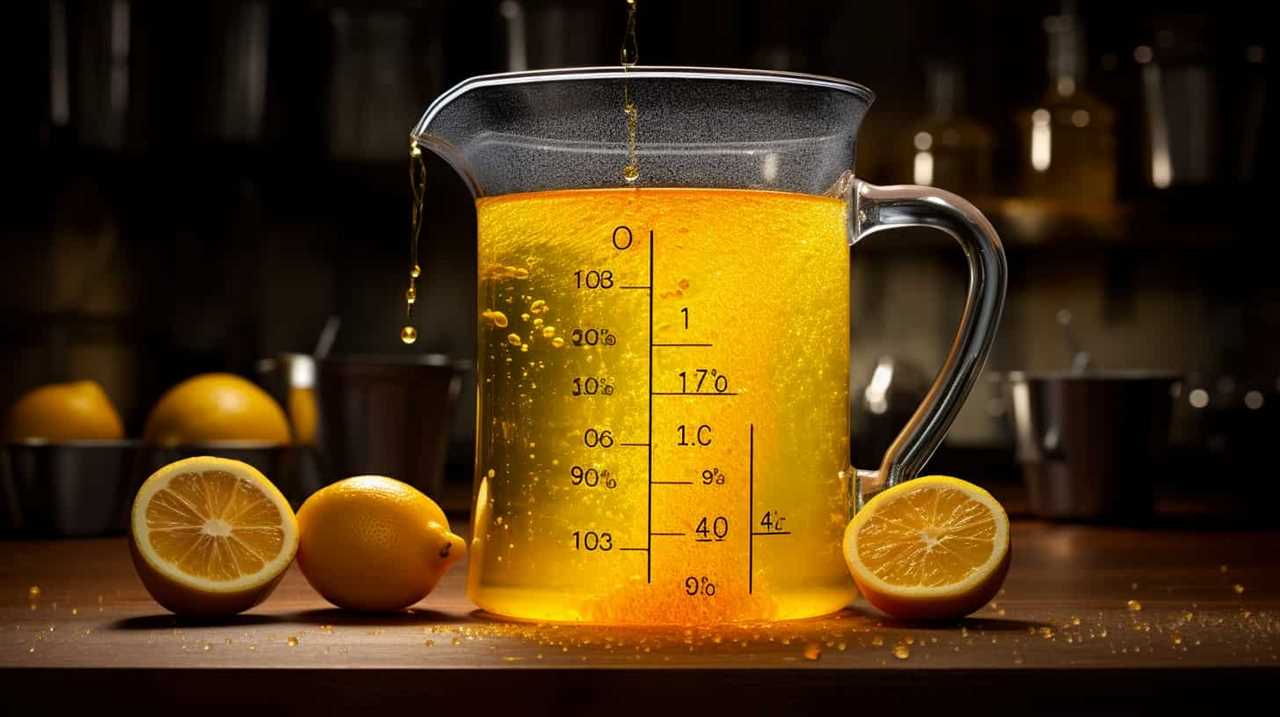
It’s important to note that while some natural variations in scent can occur due to the specific variety of oranges used, any strong or unpleasant smells should raise concerns. If you have citrus fruit allergies, it’s especially important to pay attention to the smell of orange juice, as it could indicate the presence of spoilage or contamination.
Ensuring the quality of orange juice is essential as it’s a popular beverage known for its health benefits, including being rich in vitamin C and antioxidants.
Off Taste of Orange Juice
Our taste buds can detect even the slightest hint of an off taste in orange juice, which can indicate that it has gone bad. The taste of orange juice should be fresh, tangy, and slightly sweet. If it tastes sour, bitter, or fermented, it’s likely spoiled.
One common cause of an off taste in orange juice is the use of overripe oranges. When oranges become overripe, their flavor profile changes, resulting in a less pleasant taste. Another factor to consider is the expiration date. Orange juice that has passed its expiration date is more likely to develop an off taste. It’s important to check the expiration date before consuming orange juice to ensure its freshness and quality. Additionally, improper storage conditions, such as leaving the juice at room temperature for extended periods, can lead to the development of unpleasant flavors. Storing orange juice in the refrigerator helps maintain its freshness for longer. For those exploring different juice options, aloe vera juice flavor tips suggest pairing tart juices with milder flavors to balance the overall taste.
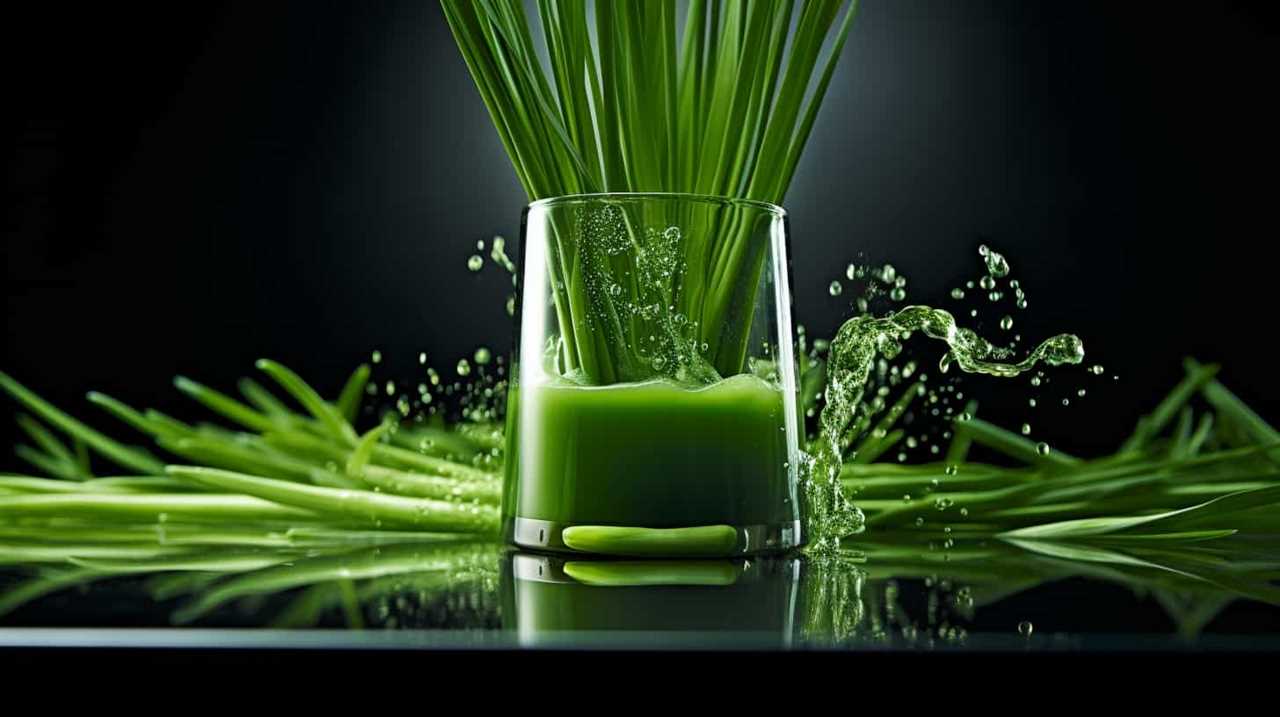
Now, let’s move on to discuss the texture changes in orange juice.
Texture Changes in Orange Juice
As we explore the texture changes in orange juice, it’s important to note that certain factors can cause it to become thicker or develop sediment. One common texture change in orange juice is pulp separation, where the pulp separates from the liquid and settles at the bottom. This can occur naturally over time, as the pulp particles become denser and sink.
Another factor that can affect the texture of orange juice is the expiration date. As orange juice ages, it may start to develop a thicker consistency and even form sediment. This is a result of the natural breakdown of the juice’s components. Therefore, it’s crucial to check the expiration date on orange juice and consume it before it reaches its expiration date to avoid any undesirable texture changes.
Mold or Growth in Orange Juice
We need to be aware of the possibility of mold or other growth occurring in orange juice. Mold can develop in orange juice if it isn’t stored properly or if it has passed its expiration date.

To prevent mold growth, it’s important to follow these steps:
- Store orange juice in the refrigerator at a temperature below 40°F (4°C).
- Check the expiration date on the bottle before consuming. Discard any orange juice that has expired.
- Keep the container tightly sealed to prevent air and moisture from entering, as these can promote mold growth.
Regularly inspecting orange juice for any signs of mold or unusual growth is essential. If you notice any discoloration, a strange odor, or visible mold, it’s best to discard the juice to avoid any potential health risks.
Frequently Asked Questions
Can Orange Juice Go Bad if It’s Stored in the Freezer for Too Long?
Frozen orange juice can potentially lose its nutrients and change its taste if stored in the freezer for too long. It is important to check for signs of spoilage before consuming it.
How Long Can Orange Juice Stay Fresh in the Refrigerator Once It’s Opened?
Once opened, orange juice can stay fresh in the refrigerator for about 7-10 days. To maintain its freshness, store it properly by keeping it tightly sealed and at a consistently cold temperature. If the orange juice develops an off odor, flavor, or appearance, it’s best to discard it to avoid any potential health risks. Factors like exposure to air and varying temperatures can influence how long orange juice lasts, so it’s crucial to handle it with care. Always check the expiration date as a general guide, but remember that proper storage can extend its freshness slightly. Additionally, avoid leaving the orange juice out at room temperature for extended periods, as this can significantly shorten how long orange juice lasts. Freezing the juice can be another option to extend its shelf life, but be aware that this may alter its texture and taste once thawed. By following these precautions, you can ensure your orange juice stays fresh and safe to consume.
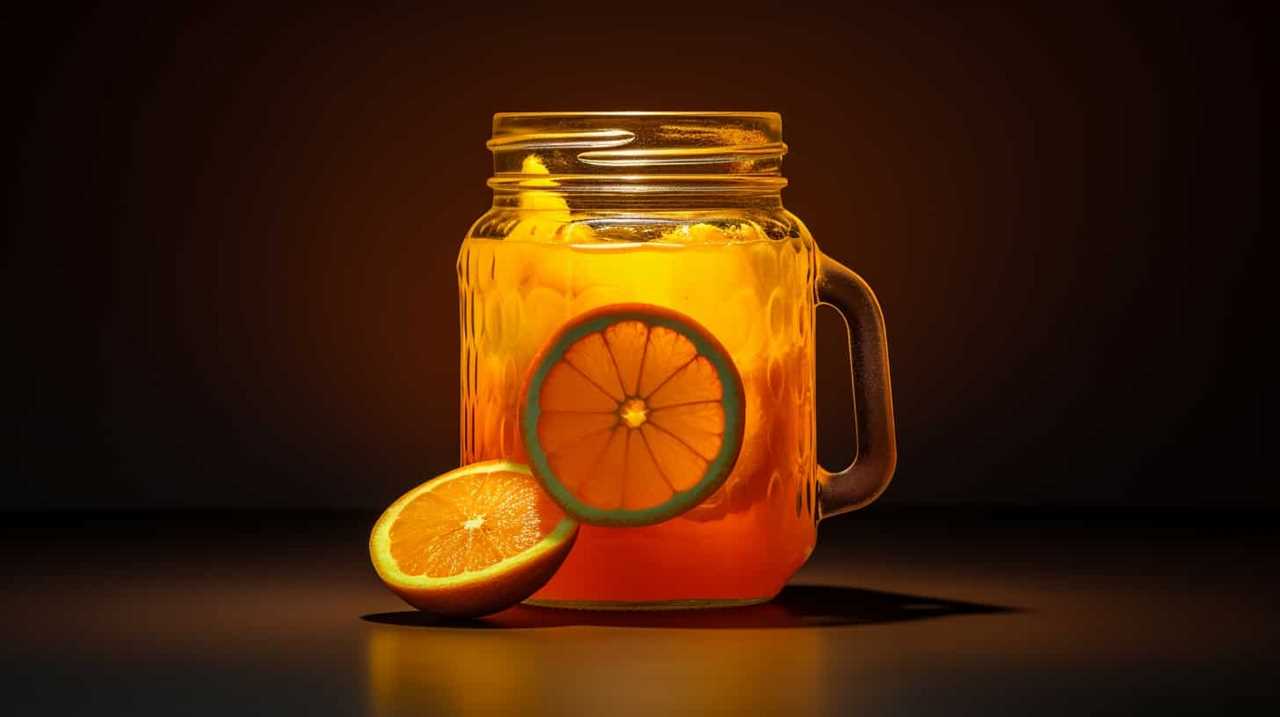
Is It Safe to Consume Orange Juice That Has Been Left Out at Room Temperature Overnight?
Left out orange juice may not be safe to drink as it can harbor harmful bacteria. Signs of spoiled orange juice include a sour smell, mold growth, and a change in color or taste.
Can Orange Juice Develop Harmful Bacteria if It’s Past Its Expiration Date but Still Looks and Smells Fine?
Orange juice can cause food poisoning if it develops harmful bacteria, even if it looks and smells fine. Signs of spoiled orange juice include a sour smell, mold growth, and a change in color or taste.
Does the Nutritional Value of Orange Juice Decrease as It Starts to Go Bad?
As orange juice goes bad, its nutritional value decreases. The longer it sits on the shelf, the more nutrients it loses. Signs of spoilage include a sour smell, off taste, and mold growth.
Conclusion
In conclusion, determining if orange juice is bad requires careful observation of color changes, strange smells, off taste, and texture changes. Just like a detective investigating a case, we must rely on our senses to detect any signs of spoilage.
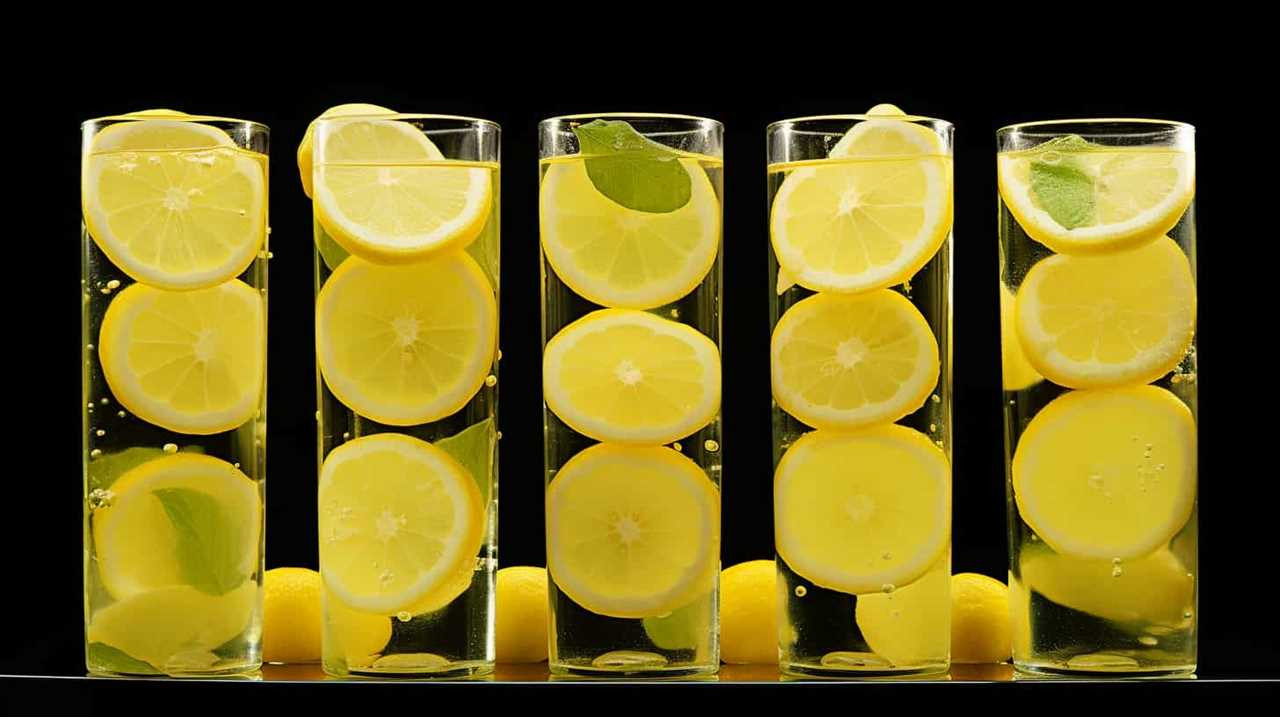
If we detect mold or growth in the orange juice, it’s a clear indication that it’s no longer safe to consume. By remaining vigilant and attuned to these indicators, we can ensure that our orange juice is always fresh and enjoyable.
Susannah expertise lies in researching and compiling evidence-based content on juicing, nutrition, and overall health. She is committed to ensuring that The Juicery World offers accurate, up-to-date, and trustworthy information to empower readers to take control of their health. Susannah’s goal is to inspire individuals to embrace juicing as a way to nourish their bodies and live their best lives.
-

 Vetted2 months ago
Vetted2 months ago15 Best Juices for Diabetics: Refreshing Options That Won’t Spike Your Blood Sugar
-

 Vetted2 months ago
Vetted2 months ago15 Best Decaf Coffee Options for Flavor Lovers Who Need a Caffeine Break
-

 Vetted2 months ago
Vetted2 months ago15 Best Espresso Ground Coffees to Elevate Your Morning Brew
-

 Vetted2 months ago
Vetted2 months ago15 Best K-Cup Coffee Pods for a Perfect Brew Every Time
-

 Vetted2 months ago
Vetted2 months ago15 Best Beans for Espresso: A Guide to Perfecting Your Brew
-

 Vetted2 months ago
Vetted2 months ago15 Best Inexpensive Espresso Machines That Brew Quality Coffee on a Budget
-

 Vetted2 months ago
Vetted2 months ago15 Best Kona Coffees to Savor the Rich Flavors of Hawaii
-

 Vetted2 months ago
Vetted2 months ago15 Best Cold Brew Coffees to Keep You Refreshed All Summer Long




